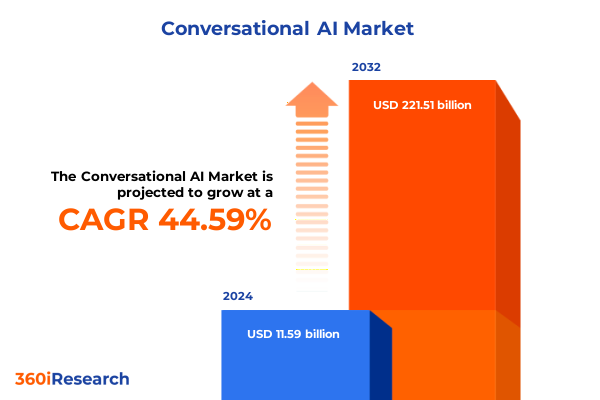The Conversational AI Market size was estimated at USD 11.59 billion in 2024 and expected to reach USD 16.82 billion in 2025, at a CAGR of 44.59% to reach USD 221.51 billion by 2032.

Harnessing Conversational AI to Propel Enterprise Transformation and Enhance Customer Engagement in a Dynamic Digital Landscape
Conversational AI has swiftly transitioned from a nascent technological novelty to a fundamental enabler of digital transformation across enterprises worldwide. As organizations strive to deliver more personalized, scalable, and efficient interactions with customers and employees alike, the imperative to integrate advanced natural language processing and machine learning capabilities into core workflows has never been stronger. This report offers a holistic view of the opportunities and challenges poised by conversational AI, weaving together market dynamics, technological breakthroughs, regulatory influences, and competitive intelligence.
Identifying the Key Technological and Operational Breakthroughs Redefining Conversational AI Adoption Across Industries
A new generation of AI agents is redefining how businesses automate complex tasks, moving well beyond static chatbots to systems that autonomously research, reason, and execute multi-step objectives. Industry leaders emphasize that these agents must demonstrate true problem-solving prowess rather than mere query-response mimicry, allowing them to navigate unfamiliar challenges with minimal human intervention. Concurrently, the rise of explainable AI frameworks is fostering transparency, enabling organizations to trace decision pathways and build stakeholder trust in high-risk applications like healthcare and finance. Moreover, hyper-specialized, domain-specific intelligence is emerging as a strategic priority, with vendors delivering tailored conversational solutions optimized for regulated industries, an approach that has proven to enhance accuracy and compliance in sectors such as legal services and life sciences. These transformational shifts underscore a broader move toward modular, scalable ecosystems in which autonomous agents collaborate seamlessly with human teams to drive productivity and innovation.
Understanding the Comprehensive Effects of Newly Imposed United States Tariffs on Conversational AI Supply Chains and Cost Structures
The reintroduction of broad U.S. tariffs in 2025 has had profound implications for the conversational AI market’s hardware and software supply chains. Leading equipment manufacturers have warned that proposed tariffs could inflate the cost of critical components such as lithography machinery and semiconductors, delaying capital investments and dampening growth projections for advanced AI infrastructures. Import restrictions on electronic components have driven procurement teams to reassess global sourcing strategies, accelerating nearshoring initiatives in Mexico and regional manufacturing clusters across North America. These measures, while aimed at bolstering domestic production, have introduced short-term cost increases that ripple through cloud and on-premises deployments alike, elevating total cost of ownership for enterprise conversational platforms. Economists caution that sustained semiconductor tariffs could shave notable percentages off U.S. GDP growth over the next decade, underscoring the strategic imperative for industry stakeholders to lobby for targeted exemptions and invest in tariff mitigation tactics.
Unveiling Critical Market Segments Illuminating Demand Patterns and Strategic Opportunities Within the Conversational AI Ecosystem
A nuanced analysis of the conversational AI landscape reveals distinct opportunity zones defined by offering models, channel preferences, deployment modalities, enterprise scale, end-user verticals, and functional applications. Services-oriented engagements, encompassing both managed and professional services, continue to attract demand from organizations seeking expert guidance on implementation, customization, and governance. Simultaneously, software-centric solutions are evolving to embed conversational capabilities into CRM and ERP platforms, catering to enterprises that prioritize rapid deployment and in-house control. Channel strategies are differentiating along multimodal, text-based, and voice-based lines, with messaging apps and web chatbots driving most customer service automation use cases. Cloud-native architectures dominate greenfield deployments, while on-premises setups persist in highly regulated sectors. Large enterprises and SMEs alike are investing in conversational AI, yet their objectives diverge: the former seeks enterprise-wide operational efficiency, and the latter focuses on targeted customer-facing improvements. Across end users, the automotive, banking, education, government, healthcare, media, retail, telecom, travel, and energy sectors exhibit varied adoption curves, reflecting unique compliance, integration, and performance requirements. Finally, application-level segmentation underscores differentiated value propositions, from proactive alerts and notifications to in-store assistance, sales augmentation, training bots, and virtual personal assistants that streamline both consumer interactions and internal workflows.
This comprehensive research report categorizes the Conversational AI market into clearly defined segments, providing a detailed analysis of emerging trends and precise revenue forecasts to support strategic decision-making.
- Offering
- Channel Type
- Deployment Mode
- Enterprise Size
- End-user
- Application
Highlighting Regional Dynamics and Growth Drivers Across the Americas, EMEA, and Asia-Pacific Conversational AI Deployments
Regional dynamics play a pivotal role in shaping conversational AI adoption, with the Americas leading in enterprise investment and innovation partnerships. North American organizations benefit from mature cloud infrastructure, robust venture capital pipelines, and favorable regulatory trends that encourage AI experimentation and scaling. In Europe, Middle East, and Africa, data privacy regulations and multilingual requirements have catalyzed unique local solutions, while geopolitical considerations influence vendor selection and cross-border dataflows. Asia-Pacific markets, characterized by vibrant government-backed AI initiatives and rapidly digitizing industries, are driving high-volume deployments in e-commerce, telecommunications, and urban mobility. Each region’s growth drivers and regulatory contexts inform go-to-market strategies, necessitating localized product roadmaps and partner ecosystems to address distinct compliance regimes, language diversity, and infrastructure maturity.
This comprehensive research report examines key regions that drive the evolution of the Conversational AI market, offering deep insights into regional trends, growth factors, and industry developments that are influencing market performance.
- Americas
- Europe, Middle East & Africa
- Asia-Pacific
Examining Leading Technology Providers and Innovative Startups Shaping the Competitive Landscape of Conversational AI Solutions
The competitive landscape of conversational AI is anchored by established technology giants and an emerging cohort of specialized challengers. OpenAI’s recent introduction of an autonomous ChatGPT agent that integrates web browsing, file manipulation, and API orchestration illustrates its push toward end-to-end digital task automation, initially targeting Pro and enterprise subscribers with usage safeguards and “watch mode” functionality. Google and Microsoft continue to leverage deep pockets and global sales channels to embed conversational modules into productivity suites, battling for share in both cloud-native and on-prem markets. Amazon’s Lex offering and IBM’s Watson maintain relevance in vertical solutions, supported by strong professional services arms. Meanwhile, startups are carving out niches with emotion-aware bots, industry-specific intelligence, and low-code creating platforms that democratize bot development. Partnerships between legacy vendors and system integrators further intensify, driving value-added services around compliance, data governance, and change management as critical differentiators.
This comprehensive research report delivers an in-depth overview of the principal market players in the Conversational AI market, evaluating their market share, strategic initiatives, and competitive positioning to illuminate the factors shaping the competitive landscape.
- Amazon Web Services, Inc.
- Avaamo, Inc.
- Baidu, Inc
- Conversica, Inc.
- Creative Virtual Ltd.
- Google by Alphabet Inc.
- iLink Digital, Inc.
- Inbenta Holdings Inc.
- Infosys Limited
- Interactions LLC
- International Business Machines Corporation
- Kore.ai, Inc.
- LivePerson, Inc.
- LTIMindtree Limited
- Microsoft Corporation
- Nuance Communications, Inc.
- Oracle Corporation
- Persistent Systems Limited
- Posh Technologies Inc.
- Pypestream Inc.
- Rasa Technologies, Inc.
- Rulai Inc.
- ServiceNow, Inc.
- SoundHound Inc.
- Tata Consultancy Limited
- Tech Mahindra Ltd
- Uniphore Technologies Inc.
- Wipro Limited
Actionable Strategies for Enterprise Leaders to Successfully Integrate Conversational AI and Sustain a Competitive Edge in Digital Markets
To translate conversational AI potential into tangible business outcomes, industry leaders should adopt a multipronged approach. First, establish clear use cases aligned with strategic objectives, prioritizing high-impact scenarios such as customer support deflection or sales enablement. Next, invest in data quality and integration frameworks to ensure conversational engines are fed accurate, context-rich information from CRM, ERP, and other enterprise systems. Additionally, organizations must develop robust governance models that address privacy, security, and ethical considerations, embedding explainable AI principles into standard operating procedures. Equipping cross-functional teams with training and change management support will accelerate adoption and mitigate user resistance. Finally, cultivate an agile innovation culture, leveraging pilot programs and rapid iteration cycles to refine bots based on real-world feedback, while continuously monitoring performance with key metrics tied to customer satisfaction, efficiency gains, and cost avoidance.
Detailing Rigorous Research Methodology and Analytical Framework Underpinning the Comprehensive Conversational AI Market Study
This study combines comprehensive secondary research, primary interviews, and rigorous data triangulation to deliver actionable insights. Secondary sources include peer-reviewed journals, industry whitepapers, regulatory filings, and reputable news outlets. Primary data was gathered through structured interviews with C-level executives, IT leaders, and solution architects across a representative sample of global organizations deploying conversational AI. Market segmentation was defined using standardized frameworks that categorize by offering type, channel, deployment, enterprise size, vertical, and application focus. Quantitative analysis was supported by supplier disclosures, government trade statistics, and proprietary survey data covering end-user preferences and satisfaction levels. All findings were validated through a multi-stakeholder review process, ensuring accuracy and relevance in an evolving market landscape.
This section provides a structured overview of the report, outlining key chapters and topics covered for easy reference in our Conversational AI market comprehensive research report.
- Preface
- Research Methodology
- Executive Summary
- Market Overview
- Market Insights
- Cumulative Impact of United States Tariffs 2025
- Cumulative Impact of Artificial Intelligence 2025
- Conversational AI Market, by Offering
- Conversational AI Market, by Channel Type
- Conversational AI Market, by Deployment Mode
- Conversational AI Market, by Enterprise Size
- Conversational AI Market, by End-user
- Conversational AI Market, by Application
- Conversational AI Market, by Region
- Conversational AI Market, by Group
- Conversational AI Market, by Country
- Competitive Landscape
- List of Figures [Total: 32]
- List of Tables [Total: 693 ]
Synthesizing Key Insights and Anticipating Future Trajectories in the Evolution of Enterprise Conversational AI Adoption
As enterprises navigate the complexities of digital transformation, conversational AI has emerged as a cornerstone technology-advancing customer engagement, operational efficiency, and decision support. This summary has illuminated the interplay of technological innovations, regulatory dynamics, and competitive forces shaping the market’s trajectory. Looking ahead, further breakthroughs in multimodal interfaces, emotional intelligence, and autonomous agents will continue to expand the boundary of what conversational platforms can achieve. Success will hinge on an organization’s ability to orchestrate these capabilities within a robust governance and integration framework. By embracing an iterative, data-driven approach, businesses can captitalize on conversational AI’s promise to redefine user experiences and drive sustainable growth.
Connect with Ketan Rohom to Acquire In-Depth Conversational AI Market Research Report and Drive Strategic Decision-Making Across Your Organization
To secure your organization’s competitive edge and harness the full power of conversational AI, reach out to Ketan Rohom, Associate Director of Sales & Marketing, for details on acquiring the comprehensive market research report. By collaborating directly with Ketan, you will gain personalized guidance on how the insights and data can inform your strategic initiatives, investment decisions, and technology roadmaps. This report is an indispensable resource for executives, product managers, and innovation teams seeking to future-proof their business and capitalize on emerging opportunities in conversational AI. Connect with Ketan today to explore tailored licensing options, bulk access plans, and value-added consulting services that will empower your enterprise to lead in the era of AI-driven customer engagement.

- How big is the Conversational AI Market?
- What is the Conversational AI Market growth?
- When do I get the report?
- In what format does this report get delivered to me?
- How long has 360iResearch been around?
- What if I have a question about your reports?
- Can I share this report with my team?
- Can I use your research in my presentation?




